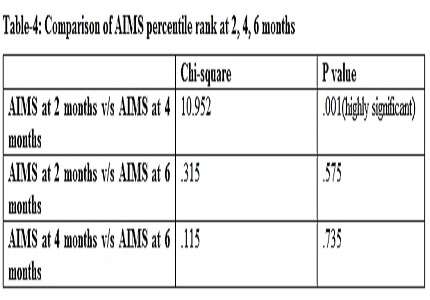Predicting the effectiveness of Test of Infant Motor Performance as an early marker of motor development delay in preterm infants
Abstract
Objectives: The purpose of this study was to determine the effectiveness of Test of Infant Motor Performance (TIMP) in detecting motor developmental delay in preterm infants.
Material and methods: The present study was conducted on 30 infants born preterm with corrected age of 2 months and follow up of TIMP at 4 months corrected age and Alberta Infant Motor Scale (AIMS) at 2, 4 and 6 months corrected age. Study period was January 2012 to December 2015.
Results: Pearson product moment correlation coefficient used to assess the relationship between the raw scores of TIMP and AIMS percentilerank at corrected age of 2 and 4 months, was 0.757 (p<0.0001) and 0.874 (p<0.0001) respectively. An analysis of the sensitivity, specificity, positive predictive value and negative predictive value of various TIMP cutoff scores for comparison with AIMS scores above and below the 10th percentile revealed the best TIMP score with a cutoff of -1 standard deviation below the mean. The results for comparison of 2, 4, 6 months corrected age AIMS data using Pearson chi square test was highly significant with p 0.001 at 2months CA AIMS data with 4 months CA AIMS data.
Conclusion and Interpretation: TIMP and AIMS are equally useful in the assessment of infant motor performance at 4 months of corrected age. A cutoff score of -1 SD from the mean on TIMP was a better predictor of developmental outcome in this study.
Downloads
References
2. Stephens BE, Vohr BR. Neuro development al Outcome of the Premature I nfa nt. PediatrClin NA[Internet]. 2009;56(3):631–46. Available from: http://dx.doi.org/10.1016/j.pcl.2009.03.005.
3. Campbell SK. Test-retest reliability of the Test of Infant Motor Performance. Pediatric Physical Therapy. 1999;11:60–66.
4. Campbell SK. The Test of Infant Motor Performance. Test User’s Manual Version 2. Chicago, IL: Infant Motor Performance Scales, LLC; 2005.
5. Campbell SK, Kolobe THA. Concurrent Validity of the Test of Infant Motor Performance with the Alberta Infant Motor Scale.Pediatric Physical Therapy. 2000;12:2–9.6.
6. Maratha Piper, Johanna Darrah. Motor Assessment of Developing Infant. Philadelphia: W.B. Saunders company;2004.
7. Campbell SK, Kolobe TH, Wright BD, Linacre JM. Validity of the Test of Infant Motor Performance for prediction of 6-, 9- and 12-month scores on the Alberta Infant Motor Scale. DevMedChild Neurol. 2002 Apr;44(4):263-72. [PubMed]
8. Thubi HA Kolobe, Michelle Bulanda, Louisa Susman. Predicting motor outcome at preschool age for infants tested at 7, 30, 60 and 90 days after term age using the Test of Infant Motor Performance. Physical therapy 2004;84:1144-1156.

Copyright (c) 2017 Author (s). Published by Siddharth Health Research and Social Welfare Society

This work is licensed under a Creative Commons Attribution 4.0 International License.


 OAI - Open Archives Initiative
OAI - Open Archives Initiative


